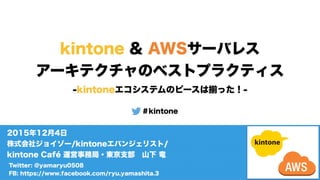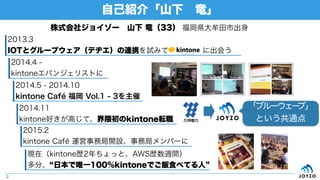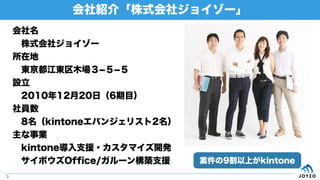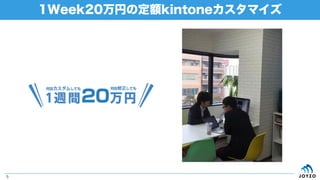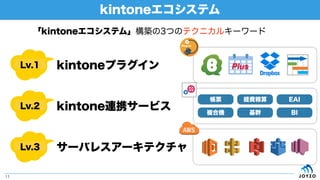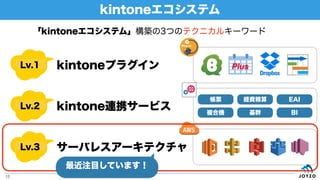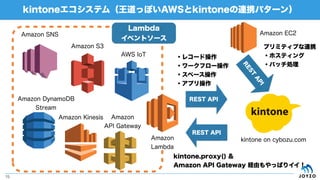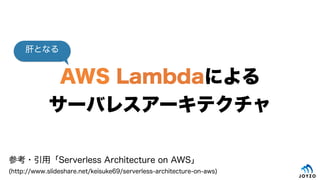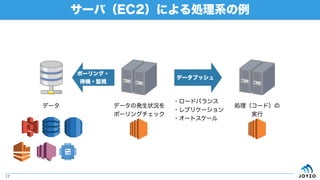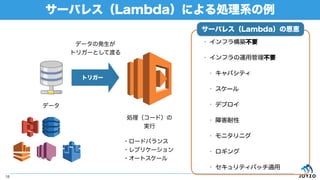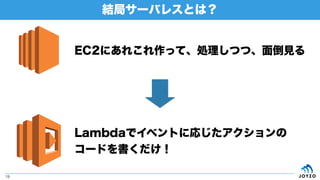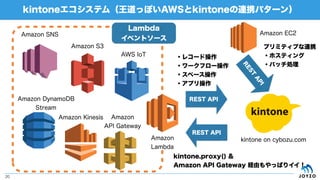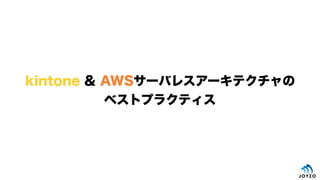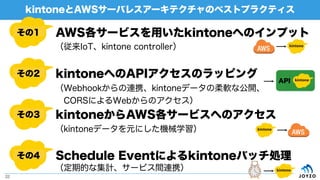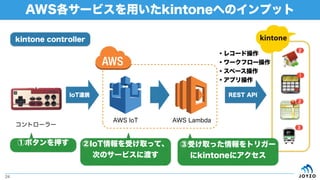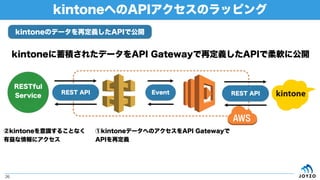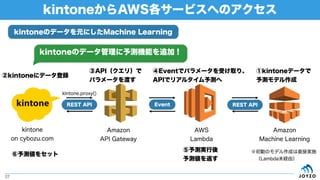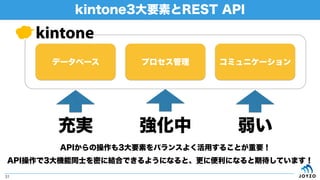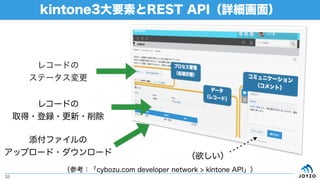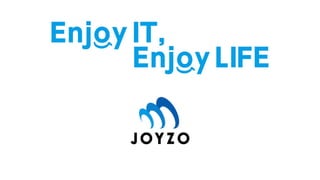kintone & AWSサーバレスアーキテクチャのベストプラクティス
- 1. Twitter: @yamaryu0508 FB: https://www.facebook.com/ryu.yamashita.3 2015年12月4日 株式会社ジョイゾー/kintoneエバンジェリスト/ kintone Café 運営事務局?東京支部?山下 竜 kintone & AWSサーバレス アーキテクチャのベストプラクティス -kintoneエコシステムのピースは揃った!- #kintone
- 2. 自己紹介「山下?竜」 2 2013.3 IOTとグループウェア(デヂエ)の連携を試みてkintone?に出会う 2014.4 - kintoneエバンジェリストに 2014.11 kintone好きが高じて、界隈初のkintone転職 2015.2 kintone Café 運営事務局開設、事務局メンバーに 2014.5 - 2014.10 kintone Café 福岡 Vol.1 - 3を主催 現在(kintone歴2年ちょっと、AWS歴数週間) 多分、 日本で唯一100%kintoneでご飯食べてる人 株式会社ジョイゾー?山下 竜(33) 福岡県大牟田市出身 「ブルーウェーブ」 という共通点
- 14. kintoneとAWS 14 ? アプリケーション寄りPaaS(SaaS) ? クライアントサイド/フロントエンド (UI/UX) ? 行動的/解釈の共有でアクションを起こし、 コミュニケーションで業務を回す ? インフラ寄りPaas(IaaS、BaaS) ? サーバーサイド/バックエンド??? (コマンド) ? 思考的/データを捌き事象を解釈する APIで 結合?補完 良質のインプット 強力なデータ処理
- 15. kintoneエコシステム(王道っぽいAWSとkintoneの連携パターン) 15 Amazon DynamoDB Stream Amazon SNS Amazon S3 Amazon Kinesis Amazon Lambda Amazon EC2 Lambda イベントソース REST API kintone on cybozu.com ?レコード操作 ?ワークフロー操作 ?スペース操作 ?アプリ操作 REST API kintone.proxy() & Amazon API Gateway 経由もやっぱりイイ! R EST A PI プリミティブな連携 ?ホスティング ?バッチ処理 Amazon API Gateway AWS IoT
- 16. AWS Lambdaによる サーバレスアーキテクチャ 参考?引用「Serverless Architecture on AWS」 (http://www.slideshare.net/keisuke69/serverless-architecture-on-aws) 肝となる
- 18. サーバレス(Lambda)による処理系の例 18 データ トリガー データの発生が トリガーとして渡る ?ロードバランス ?レプリケーション ?オートスケール 処理(コード)の 実行 ? インフラ構築不要 ? インフラの運用管理不要 ? キャパシティ ? スケール ? デプロイ ? 障害耐性 ? モニタリニグ ? ロギング ? セキュリティパッチ適用 サーバレス(Lambda)の恩恵
- 20. kintoneエコシステム(王道っぽいAWSとkintoneの連携パターン) 20 Amazon DynamoDB Stream Amazon SNS Amazon S3 Amazon Kinesis Amazon Lambda Amazon EC2 Lambda イベントソース REST API kintone on cybozu.com ?レコード操作 ?ワークフロー操作 ?スペース操作 ?アプリ操作 REST API kintone.proxy() & Amazon API Gateway 経由もやっぱりイイ! R EST A PI プリミティブな連携 ?ホスティング ?バッチ処理 Amazon API Gateway AWS IoT
- 22. その3 その2 kintoneとAWSサーバレスアーキテクチャのベストプラクティス 22 その1 AWS各サービスを用いたkintoneへのインプット kintoneへのAPIアクセスのラッピング kintoneからAWS各サービスへのアクセス (従来IoT、kintone controller) (Webhookからの連携、kintoneデータの柔軟な公開、 ?CORSによるWebからのアクセス) (kintoneデータを元にした機械学習) その4 Schedule Eventによるkintoneバッチ処理 API (定期的な集計、サービス間連携)
- 24. AWS各サービスを用いたkintoneへのインプット 24 kintone controller REST API AWS LambdaAWS IoT コントローラー IoT連携 ?レコード操作 ?ワークフロー操作 ?スペース操作 ?アプリ操作 ①ボタンを押す ②IoT情報を受け取って、 次のサービスに渡す ③受け取った情報をトリガー にkintoneにアクセス
- 26. kintoneへのAPIアクセスのラッピング 26 ①kintoneデータへのアクセスをAPI Gatewayで APIを再定義 ②kintoneを意識することなく 有益な情報にアクセス kintoneに蓄積されたデータをAPI Gatewayで再定義したAPIで柔軟に公開 kintoneのデータを再定義したAPIで公開 REST API Event REST API RESTful Service
- 27. kintoneからAWS各サービスへのアクセス 27 kintoneのデータを元にしたMachine Learning AWS Lambda kintone on cybozu.com ①kintoneデータで 予測モデル作成 Amazon API Gateway Amazon Machine Learning ②kintoneにデータ登録 ③API(クエリ)で パラメータを渡す ④Eventでパラメータを受け取り、 APIでリアルタイム予測へ REST API Event REST API ⑤予測実行後 予測値を返す ※初動のモデル作成は直接実施 ?(Lambda未経由) ⑥予測値をセット kintone.proxy() kintoneのデータ管理に予測機能を追加!
- 28. kintoneからAWS各サービスへのアクセス 28 REST API Event REST API Device Shadow SOAP API ①スイッチON/OFF ②API GatewayとLambdaを介して、 Device ShadowのREST APIをコール ③Device Shadowで Raspberry Piを制御 ④Raspberry PiからLAN内の Wemoにアクセス ⑤家電の電源をON/OFF kintoneからAWS IoT経由で家電の電源をON/OFF
- 31. kintone3大要素とREST API 31 データベース プロセス管理 コミュニケーション 充実 強化中 弱い APIからの操作も3大要素をバランスよく活用することが重要! API操作で3大機能同士を密に結合できるようになると、更に便利になると期待しています!
- 32. kintone3大要素とREST API(ポータル画面) 32 スペースの 作成?メンバー更新等 アプリの作成?更新 (欲しい) (参考:「cybozu.com developer network > kintone API」)

